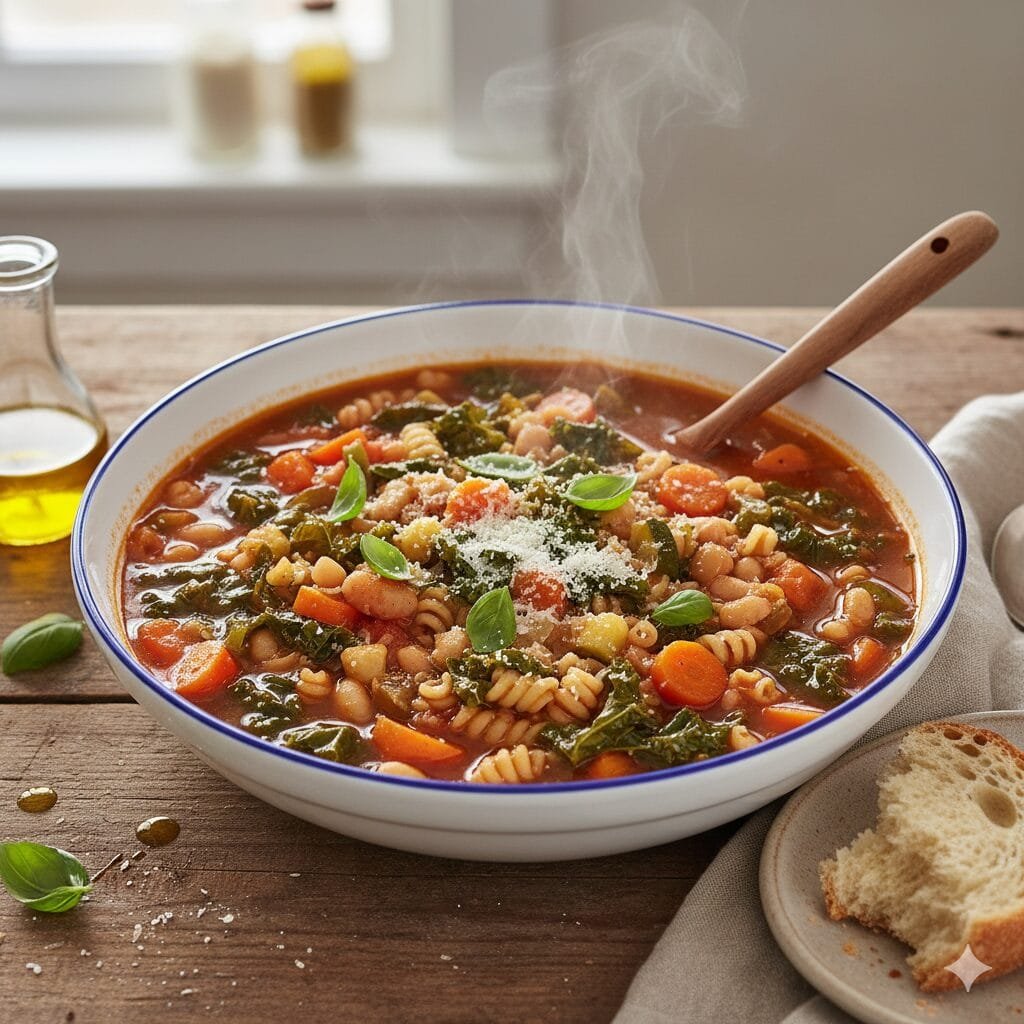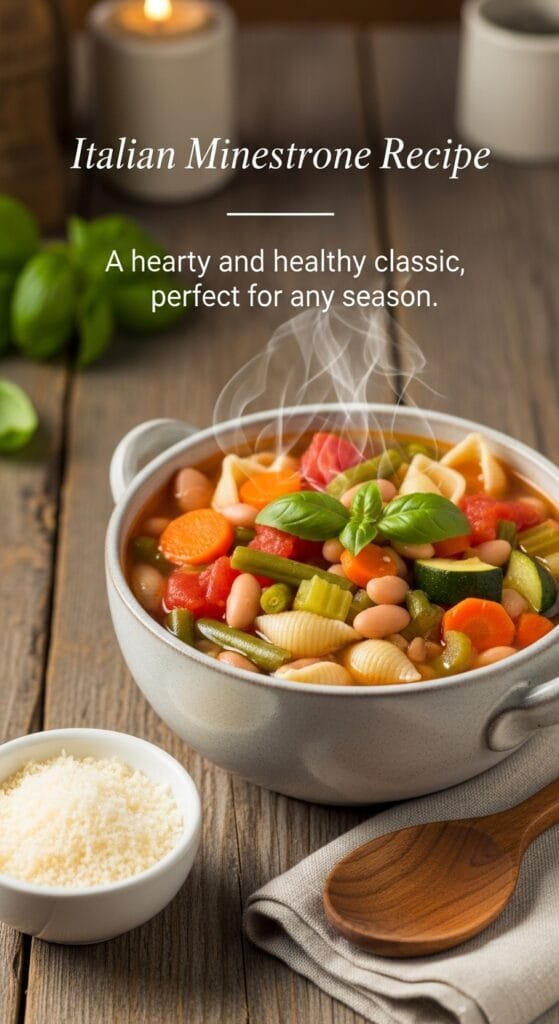
An easy, hearty Italian minestrone soup recipe awaits! This is the ultimate vegetable soup for cozy dinners and nourishing lunches. Learn how to make this traditional favorite packed with fresh, seasonal ingredients and amazing flavor. It’s simple, satisfying, and perfect for your family.
Affiliate links included. AI-assisted content, reviewed by me. [See Disclosure Page]
Why You’ll Love This Recipe
It’s a wholesome, flavorful way to enjoy lots of fresh seasonal vegetables.
This soup is incredibly comforting and makes a perfect, fulfilling meal.
What You’ll Need to Make the Recipe
Ingredients
- Fresh Vegetables: Onions, carrots, celery (the flavor base!), zucchini, potatoes, and leafy greens like kale or spinach.
- Aromatics & Herbs: Garlic, dried oregano, basil, and rosemary. Fresh basil or parsley for garnish.
- Tomatoes: Crushed or diced canned tomatoes.
- Broth: High-quality vegetable broth.
- Legumes: Canned cannellini beans or kidney beans.
- Pasta: Small-cut pasta like ditalini or tubetti.
- Pantry Staples: Olive oil, salt, and pepper.
- To Serve (Optional): Grated Parmesan cheese and crusty Italian bread.
Tools and Equipment
- Large Soup Pot or Dutch Oven: Essential for simmering all the ingredients. Choose one with a heavy bottom.
- Cutting Board and Sharp Chef’s Knife: For all the vegetable prep.
- Measuring Cups and Spoons: To ensure correct quantities.
- Wooden Spoon or Ladle: For stirring and serving.
- Vegetable Peeler: Helpful for root vegetables like carrots.
How to Make Minestrone: Step by Step
This recipe uses simple Italian cooking methods. Even a child can follow these clear steps for delicious homemade minestrone.
- Prep the Vegetables: Thoroughly wash all your fresh produce. Dice the onions, carrots, and celery into similar, small pieces. Mince the garlic. Dice the zucchini and potatoes. Chop the leafy greens like kale. Uniform cuts help everything cook evenly.
- Start the Sauté: Pour a tablespoon of olive oil into your large pot or Dutch oven. Heat it over medium heat. Add the diced onions and cook until they become clear (translucent), which takes about 5 minutes.
- Build the Flavor Base: Add the diced carrots and celery to the pot. Stir and cook for another 5 to 7 minutes until these vegetables just start to soften. This step is key for a rich flavor.
- Add Aromatics: Stir in the minced garlic and the dried herbs (oregano, basil, rosemary). Sauté for just 1 to 2 minutes. Stop when the garlic smells fragrant—don’t let it burn!
- Simmer the Broth: Pour in the canned tomatoes and the vegetable broth. Give it a good stir and increase the heat until the mixture comes to a gentle simmer.
- Cook the Vegetables: Add the remaining chopped vegetables, including the zucchini and potatoes. Reduce the heat to maintain a low simmer. Cover partially and cook for 20 to 30 minutes. The soup is ready for the next step when all the vegetables are tender.
- Finish the Soup: Stir in the chopped leafy greens (kale or spinach), the canned beans (drained and rinsed), and the uncooked small pasta (like ditalini).
- Season and Serve: Let the soup simmer for another 5 to 10 minutes until the pasta is al dente (tender but firm to the bite). Taste the soup and season with salt and pepper to your liking. The flavors will have melded perfectly!

Serving Suggestions
Serve your hot, hearty minestrone in large bowls. For an authentic Italian touch, sprinkle with freshly grated Parmesan cheese and a handful of chopped fresh basil or parsley. Always serve with a side of warm, crusty Italian bread for dipping into the flavorful broth.
Storage, Reheating, and Make Ahead
- Storage (Leftovers): Cool leftover minestrone completely. Store it in an airtight container in the refrigerator for 3 to 4 days.
- Reheating: Reheat the soup on the stovetop until it reaches a gentle simmer and is piping hot throughout. You may need to add a splash of extra broth or water, as the pasta and beans can absorb liquid overnight.
- Make Ahead (Freezing): Minestrone soup freezes well. Cool it completely first. Transfer to freezer-safe bags or containers, leaving a little space for the liquid to expand. It will stay fresh for up to 3 months. Note: If you plan to freeze, it’s best to cook the pasta separately and add it only when reheating, as frozen and thawed pasta can become overly soft.
Special Tips for Success
- Sauté First: Don’t skip the step of sautéing the onions, carrots, and celery (known as soffritto in Italian). This creates the deep base flavor for your broth.
- Adjust Thickness: If the soup is too thick, just add more vegetable broth or water until it reaches your desired consistency. If it’s too thin, you can mash a few of the cooked potatoes or beans against the side of the pot to naturally thicken the broth.
- Use Fresh Herbs: While dried herbs are used during cooking, a garnish of fresh basil or parsley added at the very end brightens the flavor dramatically.
Variations
- Different Beans: Use other hardy beans like garbanzo beans (chickpeas) or great northern beans instead of cannellini or kidney.
- Change the Leafy Greens: Try chopped Swiss chard or cabbage instead of kale or spinach.
- Add Grains: For a heartier texture, replace the small pasta with a small grain like orzo or farro.
Side Dishes
Minestrone is a meal on its own, but it pairs wonderfully with simple, classic side items:
- A light, fresh side salad with a simple lemon vinaigrette.
- A slice of warm, crusty Garlic Bread or Focaccia.
- A simple grilled cheese sandwich (for a comfort food twist).
Common Mistakes to Avoid
- Overcooking the Pasta: Add the small pasta near the very end and only cook until it’s al dente. Overcooked pasta becomes mushy and absorbs too much broth.
- Not Sautéing Enough: Rushing the initial sauté of the onions, carrots, and celery will result in a less flavorful broth. Take the time to soften them properly.
- Under-Seasoning: Taste, taste, taste! Because of the high volume of vegetables and broth, minestrone needs a good amount of salt and pepper to make the flavors truly “pop.”
A Short History
Minestrone, meaning “big soup,” is a classic Italian vegetable soup with origins rooted in the agricultural regions of Northern Italy. It began as a humble peasant dish, using whatever seasonal vegetables, grains, and legumes were readily available. Over generations, this versatile dish evolved, incorporating regional flavors and becoming a cherished staple of traditional Italian cuisine history.
Frequently Asked Questions (FAQ)
Q: What exactly is minestrone?
A: Minestrone is a thick, hearty, and versatile Italian soup recipe traditionally made with fresh seasonal vegetables, sometimes beans or small pasta, and often a touch of tomato, all simmered in a savory broth. It’s known for being healthy, filling, and a great way to use a variety of garden-fresh produce.
Q: Can I use different vegetables in minestrone?
A: Absolutely! The beauty of homemade minestrone is its flexibility. Feel free to substitute based on what’s in season or what you have. Good alternatives include butternut squash, green beans, or different types of potatoes. Just make sure to adjust cooking times for harder vegetables. This adaptability makes it a perfect vegetable soup for all seasons.
Q: Is minestrone a healthy choice?
A: Yes, this traditional Italian soup is a very nutritious soup option. It’s packed with essential vitamins and minerals from the variety of fresh vegetables (like Vitamin A, C, and K), and the beans add beneficial plant-based protein and fiber, making it a great addition to a healthy, vegetable-rich diet. It’s typically low in fat and calories.
Q: Why does my minestrone seem too thin?
A: If your soup is too thin, it may not have simmered long enough for the flavors to meld and for the broth to reduce slightly. Next time, try simmering for the full 45 to 60 minutes. As a quick fix, you can always take about a cup of the soup (including some cooked beans and potatoes), blend it until smooth, and stir it back into the pot. This is a natural way to thicken your homemade minestrone.
Q: Can I make this a vegetarian or vegan minestrone?
A: Yes, this recipe is naturally vegetarian and can be made vegan by simply omitting the final garnish of Parmesan cheese or ensuring you use a non-dairy substitute. It is a fantastic option for a plant-based or vegetable-rich diet.
Conclusion
This Italian minestrone soup is more than just a dish; it’s a centuries-old tradition of bringing simple, wholesome ingredients together into one comforting bowl. It’s easy to make, incredibly nutritious, and the perfect recipe to add to your rotation. Enjoy this taste of Italy!

Recipe Card
| Ingredient | Amount | Notes |
| Olive Oil | 1 Tbsp | |
| Onion | 1 medium | Diced |
| Carrots | 2 | Diced |
| Celery | 2 stalks | Diced |
| Garlic | 3 cloves | Minced |
| Dried Herbs | 1 tsp each | Basil, Oregano, Rosemary |
| Canned Tomatoes | 14.5 oz can | Crushed or Diced |
| Vegetable Broth | 6 cups | |
| Zucchini | 1 medium | Diced |
| Potatoes | 2 small | Diced |
| Cannellini Beans | 1 (15 oz) can | Rinsed and Drained |
| Kale or Spinach | 2 cups | Chopped |
| Small Pasta | 1/2 cup | Ditalini or Tubetti |
| Salt and Pepper | To Taste |
Prep Time: 20 minutes
Cook Time: 60 minutes
Servings: 6-8
| Step | Instructions |
| 1 | Sauté onions in oil until translucent (5 mins). |
| 2 | Add carrots and celery; cook until soft (5-7 mins). |
| 3 | Stir in garlic and dried herbs for 1-2 minutes until fragrant. |
| 4 | Add tomatoes and broth; bring to a gentle simmer. |
| 5 | Add zucchini and potatoes; simmer until tender (20-30 mins). |
| 6 | Stir in beans, kale/spinach, and pasta. Cook until pasta is al dente (5-10 mins). |
| 7 | Season with salt and pepper. Serve hot. |
Author: isaacblogger



